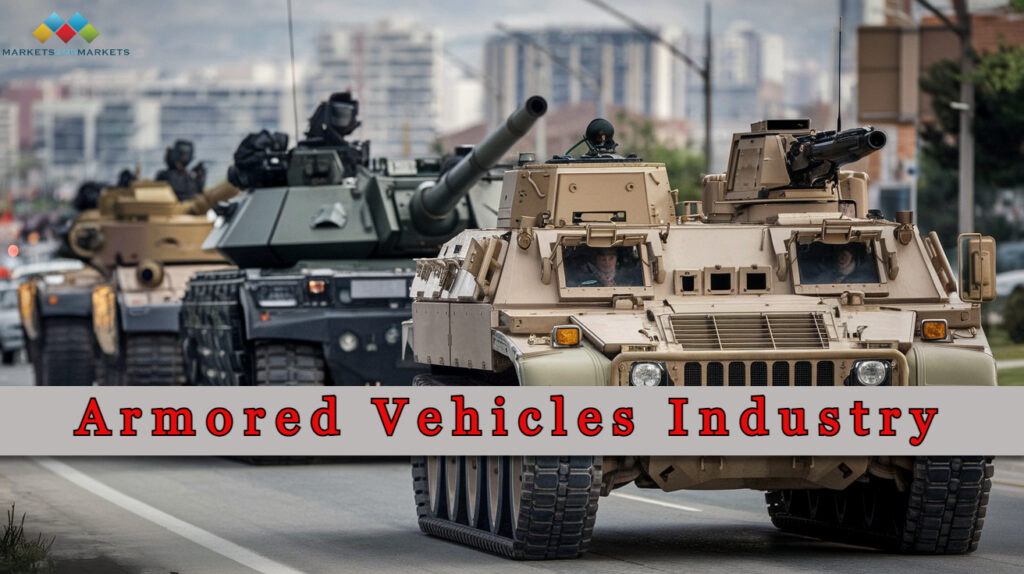Armored vehicles have become critical assets in military, law enforcement, and private sectors, thanks to their robust combination of protection, mobility, and versatility. These vehicles, designed to endure various threats such as ballistic, explosive, and chemical attacks, play a pivotal role in safeguarding troops in conflict zones and ensuring the secure transport of high-profile individuals.
Market Analysis & Forecast for Armored Vehicles Industry
The global armored vehicles market, valued at USD 51.6 billion in 2024, is projected to reach USD 60.7 billion by 2029, growing at a CAGR of 3.3% during the forecast period.

Several factors drive the growth of the armored vehicle industry:
- Geopolitical tensions and terrorism have led to increased defense spending, fueling the demand for more advanced armored vehicles.
- Military modernization programs globally are replacing aging fleets with state-of-the-art vehicles equipped with cutting-edge technologies.
- Innovation in armor materials, vehicle design, and weapons systems has drawn significant investments, further boosting market expansion.
For a detailed market report, download insights @ https://www.marketsandmarkets.com/pdfdownloadNew.asp?id=6322755
Types of Armored Vehicles
Armored vehicles vary in design and function, catering to different roles across military and civilian sectors:
- Military Armored Vehicles
- Main Battle Tanks (MBTs): The primary offensive force, MBTs, such as the M1 Abrams (USA) and Leopard 2 (Germany), feature heavy armor and large-caliber cannons.
- Armored Personnel Carriers (APCs): APCs like the M113 (USA) and Patria AMV (Finland) provide safe troop transport across battle zones, shielding infantry from small arms fire.
- Infantry Fighting Vehicles (IFVs): Heavily armed and capable of transporting troops, IFVs such as the Bradley Fighting Vehicle (USA) can engage in direct combat.
- Mine-Resistant Ambush Protected (MRAP) Vehicles: Designed to withstand IEDs and landmines, MRAPs like the Cougar and Oshkosh M-ATV (USA) have V-shaped hulls for blast deflection.
- Law Enforcement and Civilian Armored Vehicles
- Armored Cars: Utilized for secure transport of valuable assets, armored cars feature reinforced body panels and bulletproof windows.
- Armored SUVs and Sedans: VIPs and corporate leaders use armored luxury vehicles for personal security. Custom conversions of models like the Mercedes-Benz S-Class and Cadillac Escalade are popular.
Key Technologies in Armored Vehicles
- Ballistic Armor
- Steel Armor: Though strong, it is heavy, compromising speed and mobility.
- Composite Armor: Utilizes a combination of materials like ceramic plates and kevlar for lighter, more flexible protection.
- Reactive Armor: Explosive tiles detonate outward when struck by a projectile, reducing its impact.
- Active Protection Systems (APS): Advanced APS like the Trophy system can detect and neutralize incoming threats such as RPGs.
- Weaponry and Fire Control Systems
- Armored vehicles boast sophisticated weaponry, including cannons, machine guns, and guided missile systems, along with advanced fire control systems that enhance targeting accuracy in combat.
- Mobility and Engines
- Tracks vs. Wheels: While tracked vehicles offer superior off-road capabilities, wheeled armored vehicles provide better speed and fuel efficiency.
- Hybrid and Electric Engines: Increasingly, hybrid and electric systems are being researched for extended operational range and reduced environmental impact.
- Communication and Surveillance Systems
- Armored vehicles incorporate real-time communication tools, surveillance cameras, infrared sensors, and radar systems for enhanced situational awareness and coordination during operations.
Applications of Armored Vehicles
- Military Operations
- In combat, armored vehicles are essential for troop protection, firepower, and mission success. APCs and IFVs play a vital role in both combat and peacekeeping missions in volatile regions.
- Counter-Terrorism and Law Enforcement
- Law enforcement agencies use armored vehicles for hostage rescue, counter-terrorism, and crowd control. Armored cars also offer protection for high-value assets and dignitaries.
- Private Security and VIP Transport
- Armored SUVs and sedans are often employed by security firms for protecting high-profile individuals from threats like kidnapping, organized crime, and terrorism.
Challenges Facing the Armored Vehicle Industry
- Balancing Weight and Mobility
- Heavier armor offers better protection but decreases speed and maneuverability. Achieving a balance between these factors is a constant design challenge.
- Cost Considerations
- The high cost of advanced armored vehicles places a financial burden on governments and militaries, particularly in countries with smaller defense budgets.
- Evolving Threats
- As anti-armor weaponry like drones and guided missiles become more sophisticated, continued innovation in armor systems and defensive technologies is critical.
Future Trends in Armored Vehicles
- Autonomous Armored Vehicles
- The future of armored vehicles includes increased automation, with vehicles capable of operating autonomously for reconnaissance or combat missions, reducing the risk to human operators.
- Advanced Materials
- Research into materials like nanotechnology and graphene aims to create lighter and stronger armor, enabling faster, more maneuverable vehicles with enhanced protective capabilities.
- Integration with Drones and Robotics
- Future armored vehicles will likely work alongside unmanned drones and ground robots to gather intelligence, disrupt enemy forces, and provide direct fire support.
Leading Companies in the Armored Vehicle Industry
- Rheinmetall AG (Germany)
- General Dynamics Corporation (US)
- Oshkosh Corporation (US)
- BAE Systems (UK)
- Hanwha Defense (South Korea)
Ask for Sample Report @
https://www.marketsandmarkets.com/requestsampleNew.asp?id=6322755
The global armored vehicle industry is witnessing rapid growth and technological advancements. As geopolitical tensions escalate and security needs evolve, armored vehicles will remain integral to military, law enforcement, and private sector operations. From enhanced protection and mobility to the rise of autonomous systems, the future of armored vehicles will continue to shape the landscape of global security and defense.